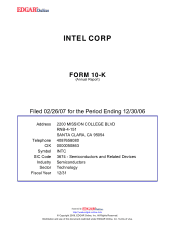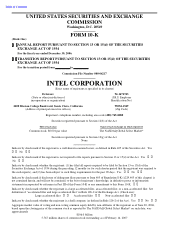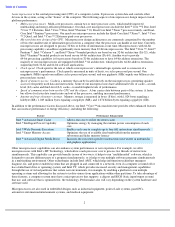Intel 2006 Annual Report Download - page 7
Download and view the complete annual report
Please find page 7 of the 2006 Intel annual report below. You can navigate through the pages in the report by either clicking on the pages listed below, or by using the keyword search tool below to find specific information within the annual report.
Table of Contents
A microprocessor is the central processing unit (CPU) of a computer system. It processes system data and controls other
devices in the system, acting as the “brains” of the computer. The following aspects of microprocessor design impact overall
platform performance:
In addition to the performance factors discussed above, our Intel
®
Core
TM
microarchitecture provides other enhanced features
that can increase performance or energy efficiency, including the following:
Other microprocessor capabilities can also enhance system performance or user experience. For example, we offer
microprocessors with Intel’s HT Technology, which allows each processor core to process two threads of instructions
simultaneously. This capability can provide benefits in one of two ways: it helps to run “multithreaded” software, which is
designed to execute different parts of a program simultaneously, or it helps to run multiple software programs simultaneously
in a multitasking environment. Other technologies include Intel AMT, which helps information technology managers
diagnose, fix, and protect enabled systems that are plugged in and connected to a network, even if a computer is turned off or
has a failed hard drive or operating system; and Intel VT, which provides increased security and management capabilities
through the use of virtual partitions that isolate user environments, for example, by enabling a platform to run multiple
operating systems and allowing for the system to isolate viruses from applications within other partitions. To take advantage of
these features, a computer system must have a microprocessor that supports: a chipset and BIOS (basic input/output system)
that use, and software that is optimized for, the technology. Performance also will vary depending on the system hardware and
software used.
Microprocessors are also used in embedded designs such as industrial equipment, point-of-sale systems, panel PCs,
automotive information/entertainment systems, and medical equipment.
2
•
Multi
-core processors. Multi-core processors contain two or more processor cores, which enable improved
multitasking and energy-efficient performance. Our dual-core microprocessors include the Intel
®
Core
TM
2 Duo, Intel
®
Core
TM
2 Extreme, Intel
®
Core
TM
Duo, Intel
®
Pentium
®
D, Dual-Core Intel
®
Xeon
®
processor family, and Dual-
Core Intel
®
Itanium
®
processors. Our quad-core microprocessors include the Quad-Core Intel
®
Xeon
®
, Intel
®
Core
TM
2 Quad, and Intel
®
Core
TM
2 Extreme quad
-
core processors.
•
Microarchitecture design of the CPU.
Microprocessor design architectures are commonly categorized by the number
of bits (the smallest unit of information processed on a computer) that the processor can handle at one time. Currently,
microprocessors are designed to process 32 bits or 64 bits of information at one time. Microprocessors with 64-bit
processing capability can address significantly more memory than 32-bit microprocessors. The Intel
®
Core
TM
, Intel
®
Pentium
®
, Intel
®
Celeron
®
, and Intel
®
Xeon
®
branded products are based on our 32-bit architecture (IA-32), while
Intel
®
Itanium
®
branded products are based on our 64-bit architecture (IA-64). Another way to provide
64-bit processing capability is for processors based on 32-bit architecture to have 64-bit address extensions. The
majority of our microprocessors are equipped with Intel
®
64 architecture, which provides 64-bit address extensions,
supporting both 32
-
bit and 64
-
bit software applications.
• Clock speed. Clock speed is the rate at which a microprocessor’s internal logic operates and is a measure of a
microprocessor’s performance. Clock speed is measured in units of hertz, or cycles processed per second. One
megahertz (MHz) equals one million cycles processed per second, and one gigahertz (GHz) equals one billion cycles
processed per second.
• Speed of memory access. Cache is a memory that can be located directly on the microprocessor, permitting quicker
access to frequently used data and instructions. Some of our microprocessors have additional levels of cache—second-
level (L2) cache and third
-
level (L3) cache
—
to enable higher levels of performance.
• Speed of communication between the CPU and the chipset. A bus carries data between parts of the system. A faster
bus allows for faster data transfer into and out of the processor, enabling increased performance.
•
Amount and type of memory storage.
Memory storage is measured in bytes (8 bits), with 1,024 bytes equaling a
kilobyte (KB), 1.049 million bytes equaling a megabyte (MB), and 1.074 billion bytes equaling a gigabyte (GB).
Feature
Performance Enhancement
Intel
®
Advanced Smart Cache
Allows one core to utilize the entire cache
Intel
®
Intelligent Power Capability
Optimizes energy by managing the runtime power consumption of each
core
Intel
®
Wide Dynamic Execution
Enables each core to complete up to four full instructions simultaneously
Intel
®
Smart Memory Access
Optimizes the use of available data bandwidth from the memory
subsystem and hides memory latency
Intel
®
Advanced Digital Media Boost
Increases the execution speed for instructions used widely in multimedia
and graphics applications




















